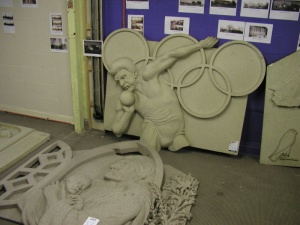Blockbusters
Contents |
Host
Original version: Bob Holness
BBC 2 version: Michael Aspel
2000 Sky version: Liza Tarbuck
Vernon Kay (2007 special)
Co-Host
Announcer (Central version): Andrew Lodge, Peter Tomlinson
Broadcast
Central for ITV, 29 August 1983 to 4 June 1993
Sky One, 1994-5
BBC 2, 31 March to 28 August 1997 (60 epsiodes)
Sky One, 2000
TalkbackThames for ITV1, 2007 (one-off)
Synopsis
First letter first
The UK version of this original American show consisted of twenty lettered hexagons. If a contestant nominated a particular space (say, W), host Bob Holness would read out a question in the format "What W is the most north-westerly state in mainland USA?"
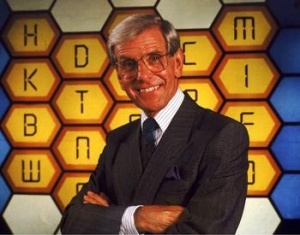 Master of ceremonies, Bob Holness
Master of ceremonies, Bob HolnessBuzzing in and answering the question correctly meant that space would be turned your colour. One player had the white spaces, and a team of two players had blue. The idea of the game was to fill in as many spaces as necessary so that a contiguous line of your colour went across the board horizontally (for the blue team) or vertically (for the white player, who could make the journey in one less space than the blues to compensate for their single-ness).
Getting a question correct also allowed you to choose the next letter. As you can see from the diagram, the single player had a shorter route than the pair of blue players.
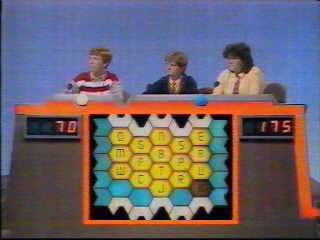 The contestants desk
The contestants deskThe board is constructed in such a way that ties weren't possible, although a frequent occurrence was the "mutual space" whereby both sides needed the same one space in order to complete their line across the board.
 One of the blue team contestants buzzes in
One of the blue team contestants buzzes inOn the run
The side who won the best of three matches went on to play the Gold Run. In this game, the participant (either the white player, or a nominated player from the blue team) had to work their way across the board from left to right within 60 seconds (or "within that magic minute", as Bob often put it). The hexagons had letter combinations such as "MTOC" and the contestants had to guess what these stood for using clues given by the host. e.g. "Famous humanitarian from India" would be "Mother Theresa of Calcutta".
 Bob Holness in the early days
Bob Holness in the early daysRegardless of whether the player won the Gold Run or not, the champion(s) went on to play another team or single player. Winning successive matches earned a chance at further Gold Runs with increasingly impressive prizes. A fourth Gold Run tended to be a holiday break somewhere in Europe, while winning the fifth and final Gold Run led to an excellent adventure holiday somewhere in the world. A failed Gold Run meant that the contestant(s) would get £10 for every correct answer. Correct answers during the main game were worth £5.
In the later series of the ITV version of Blockbusters they made an effort to cut costs, err... we mean, of course, get through more contestants by limiting players to three rounds only.
All contestants, successful or otherwise, took away the (apparently much-coveted) 'Blockbusters' sweatshirt (or rugby shirt, depending on the year), dictionary and personal organiser. The latter item varied over the Holness-years (and possibly wasn't even part of the package in the early years), but there was certainly always an item of clothing and a dictionary for everyone to take away. Pictures of the previous contestants wearing the sweatshirt/rugby shirt were invariably shown when Bob referred to the prizes.
Set and match
There are a couple of features of the set that are worth mentioning. The first is the game board, which was quite a feat of engineering. It took up the entire height of the studio, and was powered using 38 slide projectors, each with their own set of slides for the different letters, colours and Gold Run questions.
The second is the giant figureheads that adorned the top of the studio. There was a whole set of them, featuring famous people from the past. They were all made out of polystyrene that had been modelled using a hot metal wire. The chief Greek god Zeus took pride of place.
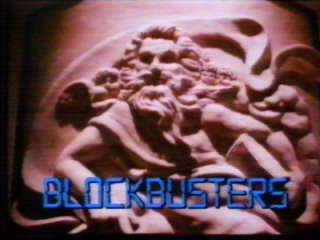 Zeus overlooks the proceedings on Blockbusters
Zeus overlooks the proceedings on BlockbustersChannel hopping
The show was dropped by ITV after ten years, only to be snapped up by Sky (with Holness still at the helm) shortly afterwards, though these episodes were also shown in some ITV regions. A spin-off ITV series, Champion Blockbusters, invited former winners back to play again. BBC 2 experimented with a cheaper afternoon version for adults which did not have the charm of the original show.
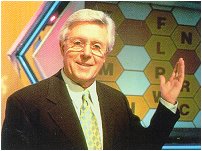 Michael Aspel tried his luck with a modern version of Blockbusters
Michael Aspel tried his luck with a modern version of BlockbustersKey moments
The students showing off their "lucky mascot" toys they had brought with them.
When Bob once asked, "What 'L' is a sum of money you borrow from a bank?" a girl answered, "Can I have a loan, please, Bob?" Bob's response was to get his wallet out straightaway!
The famous out-take (below) where a contestant answered a biology question with the response "Orgasm" instead of "Organism", and the lesser-known one where another student offered the answer "Kama Sutra" instead of "Kamakaze".
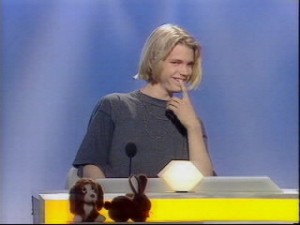 "How am I going to explain this to Mum...?"
"How am I going to explain this to Mum...?"The oh-aren't-we-wacky-students always did the weird clappy-wavy dance thing (technical term: "hand jive") that ended each fifth programme. This is because five programmes were recorded during one day, and the producers let them do it as the final thing before they went home. After extensive analysis of the tapes, we bring you the dance in full:
Knee-clap
Hand-clap
Hand-over-hand (x2)
Potato-hands (x2)
Elbow-point-twirl (x2)
Repeat x3
Knee-clap
Hand-clap
Clap in the air.
Catchphrases
At the beginning of the show on the original version: "And here is the host of Blockbusters - Bob Holness!" which later became: "And now - please welcome the host of Blockbusters - Bob Holness!"
"Put yourself on the Hot Spot, please!"
"Gold to gold in 60 seconds or less", followed by either, "Tell us where you want to start on the left and we'll start the clock" or, "We'll start the clock when you tell us where you want to start on the left".
"£10 for every correct answer if you don't make it".
"Congratulations, and this is your prize - take a look at this!"
"Retake your seat and we'll carry on with the game - thank you very much!"
"Let's play 'Blockbusters'!"
After a winning correct answer in the main game: "....And that's Blockbusters!" Michael Aspel tried to do the same, but somehow his, "....And that is Blockbusters!" never had the same ring to it, but then neither did his version of the show.
"Don't go away!"
"He/she'll be doing that Gold Run - not right now, but in a couple of minutes' time - don't you dare go away!"
There was a lot of joking around with the way in which contestants nominated the next hexagon to play for. It started with "Can I have a P please, Bob?" and progressed to "I want U, Bob" (which only the girls said, strangely enough). The 80s druggies got their kicks with "I want an E, Bob." One enterprising "rave" group, Skin Up, actually released a single called "Blockbuster" which revolved around this phrase (plus someone impersonating Bob Holness incredibly badly). Bob apparently found this rather amusing but the bigwigs at Central didn't agree and got it withdrawn. Booo!
Contestants also quite often asked for a "B for Bob", to which Bob usually responded, "If this is the answer to the question, you're in trouble, mate!" or words to that effect - but it never was!
Inventor
Blockbusters started life in the USA in 1980, one of the many Mark Goodson game-shows. The idea was spotted by a producer who piloted the show in the early 1980's in the UK.
Theme music
Composed by Ed Welch.
Trivia
One of the contestants for the pilot show was David Elias, a quiz-setter by profession who won a series of Countdown. However, when the series was commissioned it was decided that teenagers at sixth form or in college should take part. Hence, he was the oldest ever contestant on Blockbusters.
Blockbusters was notable for being the first show on British TV to run five times a week. Many thought this was overkill, but this was subsequently shown to be wrong as the show ideally slotted into the invariably tricky 5.30pm slot. [This was in the days when Home and Away was a purely Australian institution.]
In addition to the main Zeus figurehead that was above Bob, there were many others which were displayed in the studio on a rotation basis. These included: Abraham Lincoln, Isambard Kingdom Brunel, Tina Turner, Mother Teresa, George Bernard Shaw, Amy Johnston, John Wayne, Harold Macmillan, William Shakespeare, Charlie Chaplin, Winston Churchill, Meryl Streep, Einstein, Lenin, Harrison Ford, Mao Tse Tung, Kenny Dalglish, Bob Geldof, Beethoven, Martina Natratilova, Hilga Ogden, Woody Allen, Toyah Willcox, Confucius, Queen Elizabeth I, a Punk Rocker, Moses, Daley Thompson, Marilyn Monroe, a Teacher, an Astronaut, a Diver, a Rastafarian and Tutankhamen. They were made out of polystyrene, and moulded by cutting out the relevant sections using a hot wire.
The format was so successful in Dubai that shops and offices closed early so that everyone could rush home to see it. In the mid-90s, there were two editions of the show for kids in Israel - one in Hebrew, one in Arabic.
Mathematically speaking, it doesn't make any difference which space a contestant picks at any point in a game. Since whoever selects a space, it is decided by an equal race to the buzzer (so that whenever in the game a space is chosen, the same team should theoretically win it), and because a completed game board can only have one winner on it, the process of playing can be thought of as uncovering the final grid to "see" who wins. Therefore, the best tactic is arguably to simply choose the spaces that will delay the ending of the game and hence accrue a player the most cash (or, of course, to choose the letters with the most potential for hilarious innuendo). Former contestant Stuart Langley writes: "Interested to read the point about the best tactic being to fill the board and take the money as that is exactly what Anita Garrad and I did when we were on the show (many years ago). We were apparently the first and only people to do this. However, at the next ad break we were taken to one side by the producer and told not to do it again. I guess they were worried it would catch on and bankrupt the show."
Bob's trademark "sign off" of saluting his right hand into the air (usually accompanied with "Goodbye now!" or "Cheers!") was compained about by viewers who thought he was imitating the Nazi "Zeig heil" salute.
In later series, a bell would ring indicating when an advertising break was about to talk place. Bob would read out one more question before going into the ads. What purpose this served is unknown.
During the rehersals of the first Sky One series, when someone did a test Gold Run they'd put up gag prizes; two of them included an old rusty lawnmower, and the contents of the producers' drinks cabinet (a couple of cracked tumblers and an almost-empty bottle of booze).
Merchandise
Several Blockbusters quiz books were published by Sphere. A very successful board game was also made, and there was a "Gold Run" travel card game as well. In 1989, an annual was printed although this was the only one to be published to our knowledge.
Web links
Thomas Scott's contestant diary
Andy Walmsley's set design from the BBC/Sky versions.
Pictures
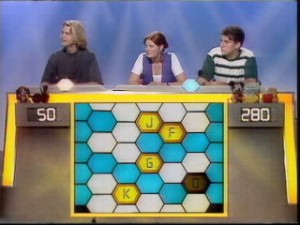 Picture 1 - A later version of the set.
Picture 1 - A later version of the set.
